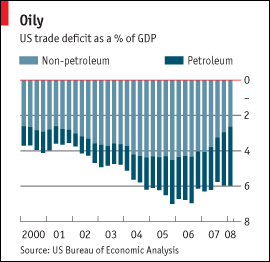News Home
Home - Index - News - Krisen 1992 - EMU - Economics - Cataclysm - Wall Street Bubbles - US Dollar - Houseprices
FEER
The dollar - FEER of falling
The purchasing-power parity, or PPP—is $1.16, according to the OECD.
Yet a euro buys as much as $1.55
The Economist print June 19th 2008
With such a discrepancy, a European visitor cannot help but feel flush. On arriving in America, his spending power is instantly boosted by a third.
The wallets of American travellers are correspondingly thinner.
The fundamental-equilibrium exchange rate (FEER), is the rate consistent with a steady economy at full employment and a sustainable current-account balance.
The FEER approach was pioneered by John Williamson at the Peterson Institute for International Economics in Washington, DC, who, with his colleague William Cline, is about to publish a paper with new estimates for 30 countries.
Judging whether a currency is seriously undervalued is much harder than you think
The Economist print June 21st 2007
There are three main ways of determining the “correct” value for a currency. The oldest is based on the theory of purchasing-power parity (PPP): the idea that, in the long run, exchange rates should equalise prices across countries (The Economist's Big Mac index is a crude version of this). More sophisticated PPP models adjust for differences in productivity or income per head, because it is natural for prices to be lower in low-income countries. They usually find that the yuan is undervalued. The biggest weakness of PPP is that the equilibrium is only a very long-run one, as it completely ignores capital flows.
The FEER approach is flawed in two ways. First, a large current-account surplus does not necessarily prove that a currency is unfairly cheap; it may just reflect countries' different savings and investment rates. Second, it is increasingly difficult to define the sustainable level of a current account in a world of mobile capital.
Yet the equilibrium value of a currency is highly sensitive to this assessment.
Stephen Jen of Morgan Stanley prefers a third method of calculating the fair value of a currency: the so-called behavioural equilibrium exchange rate. This does not attempt to define long-term economic equilibrium. Instead it analyses which economic variables, such as productivity growth, net foreign assets and the terms of trade, seem to have determined an exchange rate in the past, and then uses the current values of those variables to estimate a currency's correct value.
Morgan Stanley uses no fewer than 13 models to value currencies. Its latest update offers a wide range for the euro's fair value against the dollar from $1.02 to $1.29, with a median value of $1.15.
